|
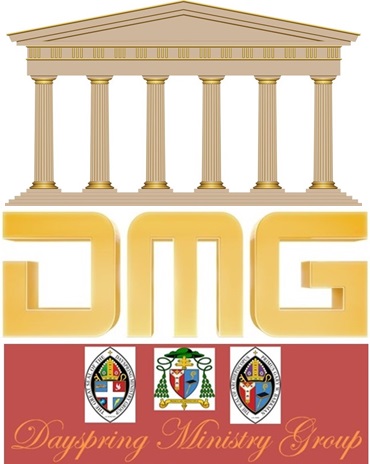

Barton Stone & Alexander Campbell
Champions Of The Second Great Awakening
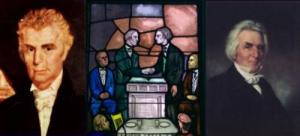
The Evangelical Christian Church (Christian Disciple) name stands out in
church history as the Restoration Movement also known historically as the "Stone-Campbell Movement, is a Christian reform
movement rooted in the "Christian Church" and traced to the 18th century in the United States and Canada during the Second
Great Awakening. Barton W. Stone and Alexander were leading figures of many independent movements with like principles who
merged together into other religious movements of significant size that became the most powerful movement in American and
Canadian history.
Since 1788, these churches can range up to the hundreds of thousands or
millions around the world. Among the newer denominations that were formed in the late 1700s, some see these groups as the
Ishmaels of the Restoration Movement. Restorationism sought to renew the whole Christian church, on the pattern set forth
in the New Testament, without regard to the creeds and hierarchical control developed over time in Catholicism, Orthodoxy,
or Reform Protestantism, which allegedly kept Christianity divided.
Leading up to the 19th, the Calvinists and Wesleyan revival, known as champions
in the Great Awakening, had established the Congregationist, Presbyterian, Baptist and new Methodist churches on competitive
footing for social influence. The numerical strength of the Baptists and Methodists rose relative to that of the denominations
dominant in the colonial period - Anglicans, Presbyterians, Congregationalists, and Reformed. Other primitivist movements
including the Paulicians, Hussites, Anabaptists, Landmarkists, and the Quakers have been described as examples of restorationists.
That is why many of Barton Stone's followers were found throughout the globe, claiming to "concentrate on the essential aspacts
of the Christian faith, allowing for a diversity of understanding with non-essentials." Basically, there are those whose beliefs
and doctrines may diifer on minor subjects, but who believe in Jesus Christ the Son of God as the Savior and authority of
the Christian church.
The Second Great Awakening (1790-1840s) was a period of great religious
revival that extended the antebellium period of the United States, with widespread Christian evangelism and conversion that
made its way across the frontier territories, fed by an intense longing for a prominent place for God in the life of the new
nation, and a new liberal attitude toward fresh interpretations of the Bible, and a contagious experience of zeal for authentic
spirituality. As these revivals spread, they gathered converts to Protestant various sects. The revivals eventually moved
freely across denominational lines, with practically identical results, and went further than ever toward breaking down the
allegiances that kept adherents to these denominations loyal to their own. Consequently, the revivals were accompanied by
a growing dissatisfaction with Evangelical churches and with the doctrine of Calvinism in particular, which was normally accepted
in most Evangelical churches at the time, has been revisit and now accepted by The Evangelical Christian Church (Christian
Disciples).
The leaders of the restorationist movenents did not believe that God intended
to simply support the pouring of new wine into old wineskins. They witnessed God miraculously changing the hearts of every
man, women and child of their old mindsets, old attitudes and old ways. They perceived the new religious awakening as the
dawn of a new church age, preaching a simple gospel stripped of "dogma" and "creeds." Restorationists sought out to re-established
or renew the whole Christian church on the pattern they held to be set forth in the New Testament. They insisted on Bible
names for Bible things. Barton Stone wanted to continue to use the name "Christian" while Alexander Campbell insisted upon
the name "Disciples." The name "Christian Disciples" became widely used as a result. They had little regard for creeds that
developed over time, and criticized Roman Catholic traditions in terms of both history and Scripture which kept Christianity
divided.
The Second Great Awakening at Cane Ridge, Kentucky helped advanced the
liberation of both black slaves and women's rights within American cultural society. Several African American Christians who
were born in slavery went on to become prominent figures in society. This became the "central and definding" moment in the
development of Afro-Christianity. In Laura, Ohio, in 1854, many African American ministers were welcomed to preach in the
pupits of various Evangelical Christian Churches while many white Evangelical Christian Church's clergy continued to minister
to mixed congrgations which was formerly unheard of. In the midst of shifts in theology and church polity, the ECC became
the first institution where both women and blacks made an important contribution in leadership roles. Women in many black
churches became, to an even degree than in white churches, the backbone of church life; many became preachers. Black women
so reared upon joining integrated churches, found it difficult to accept less crucial tasks where men dominated. The Evangelical
Christian Church excercised its independence under God by becoming one of many Restoration Movement denominations to recognize
the ordination of women.
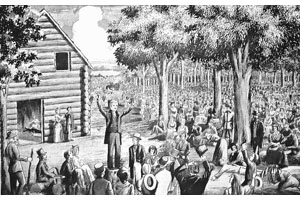
The Great Western Revival was a tidal wave of religious interest and a
new phenomenon which began in about 1800, reaching its crest in 1803, and then gradually diminishing as it merged with the
normal stream of evangelism. Its principle expansion fields were in Tennessee and Kentucky. On Sundays of May and June 1801,
there were a succession of Great Western Revival meetings at churches in the region around Lexington, Kentucky. At the last
three meetings, the attendance ran to 4,000 for the first, 8,000 for the second, and 10,000 for the third, according to contemporary
estimates. The "May communion appointment" at the Concord Church, of which Stone was a member, brought together between 5,000
and 6,000 people of various sects and many preachers of different denominations that flocked to Cane Ridge to experience a
touch from God.
The Bluegrass portion of the Ggreat Western Revival climaxed at a Cane
Ridge meeting which lasted from Friday to Wednesday, August 7-12, 1801. An estimated crowed of 20,000 gathered from miles
around in the wilderness encampment for four days to a week to hear great preachers. Presbyterian, Methodist, and Baptist
ministers preached, often simultaneously at different stations throughout the neighboring woods. As the rival interest grew,
and as the meetings became larger and longer, unexpected and spiritual manifestations, called "exercises," began to occure.
The frey preaching started at sunset and didn't stop until the night. Many people fell to their faces as the weight of their
sins struck them cold as preachers shouted to the crowd and urged repentance. Worship continued well into the week following
the serving of Communion on Sunday, in fact, until provisions for humans and horses ran out. Stone, in his Autobiography,
listed visible manifestations of the direct action of the Holy Spirit. There they engaged in an unrelenting series of intense
spiritual exercises, punctuated with cries of religious agony and ecstasy, all designed to promote religious fervor and conversions.
These exercises ranged from singing of hymns addressed to each of the spiritual stages that marked the journey to conversion,
public confessions and renunciations of sin and personal witness to the workings of the Holy Spirit, collective prayer, all
of which were surrounded by sermons delivered by clergymen especially noted for their powerful "plain-speaking" preaching.
The major variant of the new revivalism consisted of the "protracted meetings" most often associated with the "new measures"
revivalism of Charles Finney, Jonathan Edwards, and George Whitefield. They became very known as a result to changed American
life in areas such as prison reform, abolitionism, and temperance. News of their new found hope spread like wildfire through
Kentucky, and people in nearby regions began to attend the camp meetings, and were convinced that they were experiencing and
witnessing the greatest outpouring of the Holy Spirit such as the early church had known at Pentecost.
In the midst of shifts in theology and church polity, the revivals follower
an arc of great emotional power, with emphasis of the individual's sins and need to turn to Christ, resotored by the sense
of personal salvation. The sheer exhilaration of participating in a religious revival with crowds of hundreds and perhaps
thousands of people inspired themselves to praise, groan, weep aloud in prayer and song, shout, laugh, fall down to the
ground speechless, and dance while coming face to face with the living God. The noise of the meetings was so great that some
said "the noise was like the roar of the Niagara." These revival meetings swept through Kentucky, and it was also reported
that those who came to scoff were not immune to these life changing experiences. The movement which Barton Stone had stated
soon began to take on larger dimensions, and thousands (men, women, and children) were saved by the power of the Holy Spirit.
Soon greater part of Kentucky was influenced by this movement. Barton Stone never ceased to rejoice in the success of the
truth of the gospel.
He was laid to rest at Hannibal, Mo., in Novemeber, 1844, and buried at
Cane Ridge, Kentucky, while Alexander Campbell died on March 4th, 1866
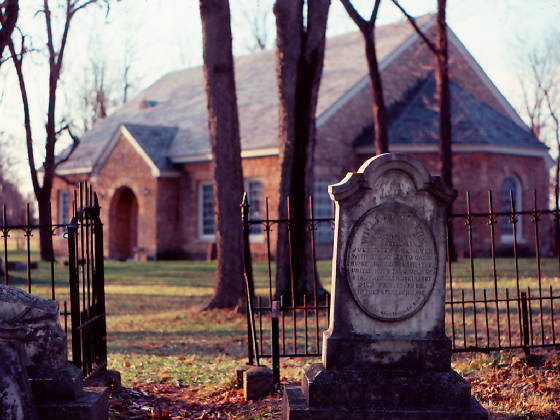
Cane Ridge Meeting Pics
Pastor Amy Barkman (no relations to Bishop Barkman) says it best.
Here is the letter she wrote of the visit after the Barkmans left for Texas:
Dear Group,
The Bishop Gary Wayne and Dwanna Barkman just left our home in Kentucky
for a 16 hour drive back to Texas. They asked that we request your prayers for their safety on the journey. We have had a
wonderful visit.
Gary Wayne Barkman of Kentucky, my husband, and Gary Wayne Barkman of
Texas, the Bishop, just met for the first time last Friday though they had corresponded first over 25 years ago when a Christian
Publishing House wrote Dr. Barkman and asked about some address confusion and he contacted the unknown address they sent him.
They discovered that not only did they have the exact same first, middle,
and last names, they were born in the same year. The acquaintance was renewed through re-discovery through internet.
The Lord led that I become affiliated with Dayspring Ministries International and I met the Texas Barkmans in February in
Arkansas at Conference.
This Saturday we went to Cane Ridge, site of the revival which is the
historic beginning of several Christian Church groups and were given a tour by Rev. John Wright and were also able to have
fellowship with him. We were interested to find out that revival was preached by "Presbyterians,Methodists, and Baptists"
and ended because "the food ran out for the people and the grass ran out for the horses."
We then went to Asbury Seminary and visited Wesley Square where Dr. Barkman
discovered that he was taller than the life size statue of John Wesley.
Yesterday morning, Sunday, Dr. Barkman preached at my church. Dr.
Stewart and Jane Pier came yesterday afternoon to our home and attended the ordination service of Rev. Don and Rev.
Marie Garland. We have all been praising the Lord for the Christian fellowship and fun we have had with all concerned.
God bless you all!
In His Grace and Mercy,
Amy Barkman
| Dr. Gary Barkman behind the Cain Ridge Pulpit |
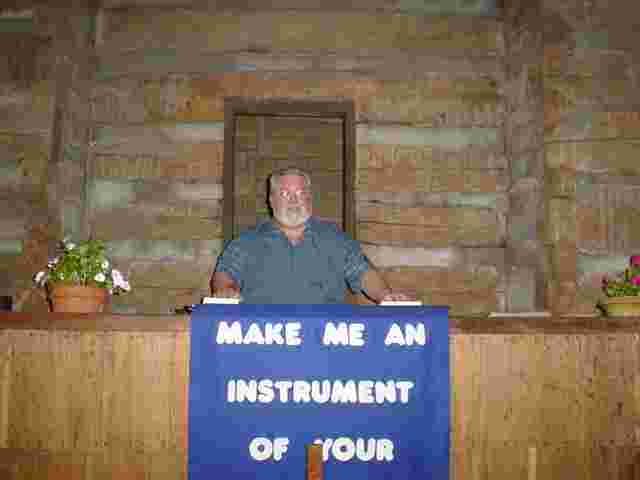
|
| The Spirit of God still abides in this place of beginnings |
| The great pulpit invites others |
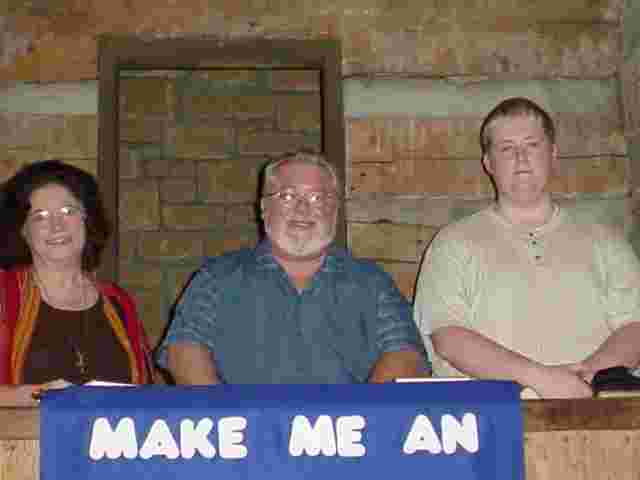
|
| Rev. Amy Barkman, Dr. Gary Barkman, Rev. John Wright |
|
